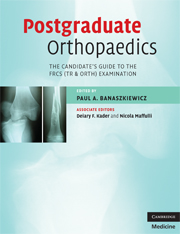Book contents
- Frontmatter
- Contents
- List of contributors
- Foreword by Mr Peter Gibson
- Preface
- Glossary
- Section 1 The FRCS (Tr & Orth) examination
- Section 2 The written paper
- Section 3 The clininicals
- Section 4 Adult elective orthopaedics oral
- 14 General oral guidance
- 15 Shoulder and elbow oral core topics
- 16 Hip oral core topics
- 17 Knee oral core topics
- 18 Foot and ankle oral core topics
- 19 Spine oral core topics
- Section 5 The hand oral
- Section 6 The paediatric oral
- Section 7 The trauma oral
- Section 8 The basic science oral
- Section 9 Miscellaneous topics
- Index
- References
19 - Spine oral core topics
from Section 4 - Adult elective orthopaedics oral
Published online by Cambridge University Press: 22 August 2009
- Frontmatter
- Contents
- List of contributors
- Foreword by Mr Peter Gibson
- Preface
- Glossary
- Section 1 The FRCS (Tr & Orth) examination
- Section 2 The written paper
- Section 3 The clininicals
- Section 4 Adult elective orthopaedics oral
- 14 General oral guidance
- 15 Shoulder and elbow oral core topics
- 16 Hip oral core topics
- 17 Knee oral core topics
- 18 Foot and ankle oral core topics
- 19 Spine oral core topics
- Section 5 The hand oral
- Section 6 The paediatric oral
- Section 7 The trauma oral
- Section 8 The basic science oral
- Section 9 Miscellaneous topics
- Index
- References
Summary
Surgical approaches
Cervical spine: anterolateral approach (Smith–Robinson)
Background information
One of the most common approaches to the neck
Extensile – allows access to all levels
Uses – anterior discectomy and fusion, anterior corpectomy and fusion or cage insertion for burst fracture, tumour or infection, kyphosis correction and vertebral artery exposure
Technique
Patient placed in supine position with their head slightly extended and fixed, i.e. in Mayfield clamp
Skin incision is made along the transverse skin crease or longitudinally
Risk of recurrent laryngeal palsy is lower with approaches from left
Platysma incised in line of incision
Fascia incised anterior to sternocleidomastoid
Blunt dissection between omohyoid/sternothyroid and midline structures
Dissect between carotid sheath (laterally) and thyroid (medially) to expose deep fascia
Can ligate thyroid artery for access
The prevertebral plane is behind the fascia deep to the posterior pharynx
Anterior longitudinal ligament divided in midline, retracted laterally with periosteum ±longus colli to improve exposure
Complications
Injury to recurrent laryngeal nerve, hypoglossal nerve, vascular or visceral injury
Neck swelling with airway compromise requiring urgent decompression; early dysphagia due to swelling
Cervical spine: posterior approach
Background information
Access to occiput and posterior elements of cervical spine
Can access the lateral masses
Carried out for posterior cervical fusion, decompression of the canal, reduction and fixation for trauma and removal of lateral discs by foraminotomy
Technique
Skull traction recommended
Patient prone, head supported (no pressure on eyes)
The shoulders are taped down, tilt head up
Midline skin incision at occipitocervical junction; incision from below occipital protuberance to C3
Fascia divided – access occiput and spinous process of C2
[…]
- Type
- Chapter
- Information
- Postgraduate OrthopaedicsThe Candidate's Guide to the FRCS (TR & Orth) Examination, pp. 237 - 270Publisher: Cambridge University PressPrint publication year: 2008



